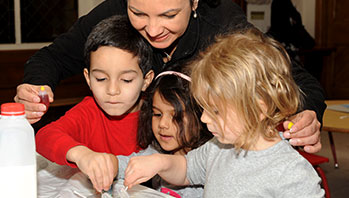- two plastic bins labeled with signs: Float and Sink
- collection of objects that float or sink (rubber bands, sponges, pencils, plastic bottles with tops, rubber ball, small wrench, wooden blocks, plastic straws, craft sticks, small plastic toys)
- large clear bin with water (one for each group)
- bag
- paper and crayons
- paper towels (for spills)
- camera or cell phone with camera
- float
- sink
MA Standards:
Mathematics/Measurement and Data/PK.MD.MA.1: Recognize the attributes of length, area, weight, and capacity of everyday objects using appropriate vocabulary (e.g., long, short, tall heavy, lights, big, small, wide, narrow).
MA Draft STE Standards:
Physical Sciences/Matter and Its Interactions: Structure and Properties of Matter/PS1.A: Describe, compare, sort and classify objects based on observable physical characteristics, uses, and whether it is manufactured as part of their classroom play and investigations of the natural and human-made world.
Head Start Outcomes:
Logic and Reasoning/Reasoning and Problem Solving: Classifies, compares, and contrasts objects, events, and experiences. Science Knowledge/Scientific Skills and Method: Observes and discusses common properties, differences, and comparisons among objects. Science Knowledge/Scientific Skills and Method: Collects, describes, and records information through discussions, drawings, maps, and charts.
PreK Learning Guidelines:
English Language Arts/Language 2: Participate actively in discussions, listen to the ideas of others, and ask and answer relevant questions. Mathematics/Patterns and Relations 7: Explore and describe a wide variety of concrete objects by their attributes.
Small Group: Bag of Objects

STEM Key Concepts: Objects behave differently in water; Some things float; Some things sink; Solids have physical characteristics that can be observed and described
ELA Focus Skills: Compare and Contrast, Follow Directions, Listening and Speaking, Vocabulary
Educator Prep: Before the activity label two sorting bins: Float; Sink and place them in the area where children will be exploring.
Gather children around the water table or a large, clear, plastic container with water. Hold up the bag of objects. Tell children they will each choose and name an object. Then each child will name the object and describe what it looks and feels like. If they know what material it is made of, encourage them to share that, too. Then have children explore whether it floats or sinks. Allow time for discussion. Review float (object stays at the top of the water) and sink (object stays at the bottom of the water).
Choose a child to reach in the bag and pull out an object. Have her or him describe the object then say, Put your hand up if you think this object will float.
- Count and record how many children respond. Repeat with “sink.” Determine which prediction has the most responses.
- Tell the child to place the object in the water.
- Have children share their observations. Ask, Did the object <sink/float> like you thought it would or did it do something different?
- Point out the “Float” and “Sink” signs on the plastic bins. Have child take the object out of the water and place it in the correct bin.
- Repeat with other objects. Let each child have a turn.
- Try putting several objects in the water at one time and let children compare how the objects behave.
Once all the objects have been explored and placed in the appropriate bins, gather children and explore the objects in the “Float” bin. Do the same with the “Sink” bin. Have children draw a picture in their science notebooks to record an item that floats or sinks. Help them label their picture.
Educator Tip: You may need to help children describe and classify objects by discussing and comparing the composition of tested objects with the new object drawn from the bag, for example, say, This letter tile is made of wood and it floated in the water. The big block is made of wood, too. Do you think the block will float or sink?
